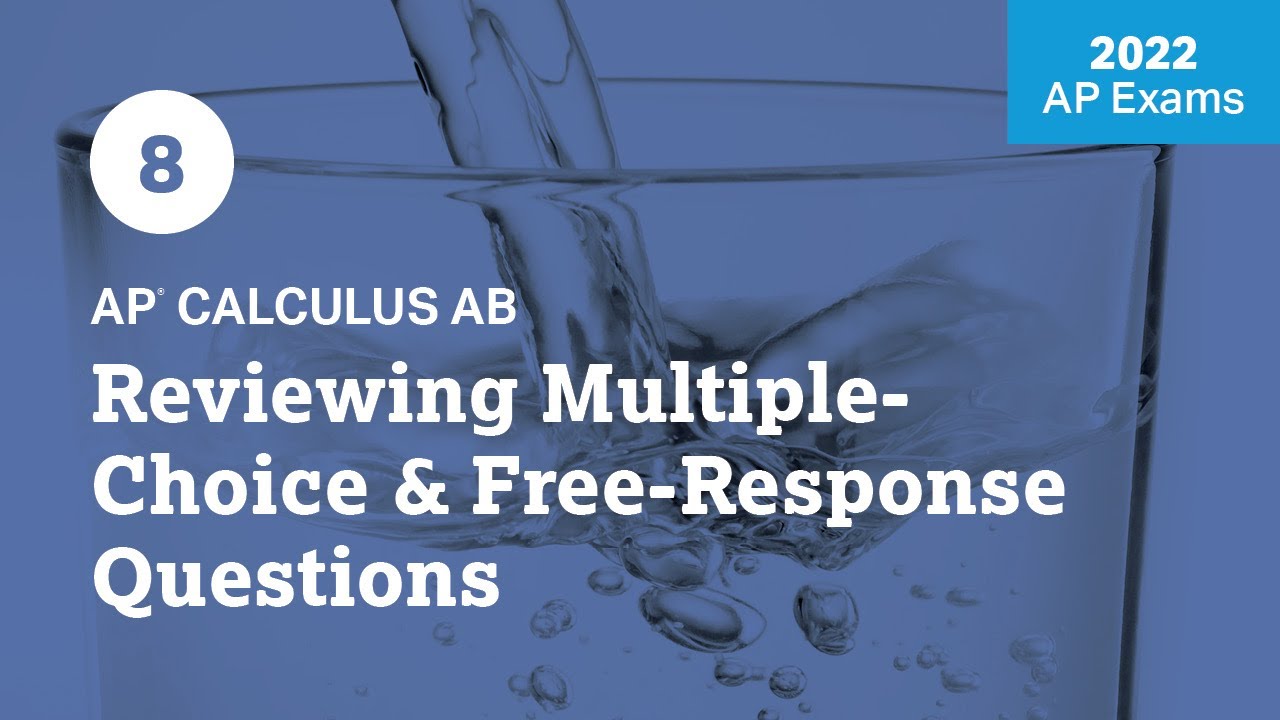2021 Live Review 8 | AP Calculus BC | Putting It All Together: Strategies & Tips for the AP Exam
TLDRIn this inspiring and informative session, the presenters share valuable advice and strategies for AP Calculus BC students preparing for their exams. They emphasize the importance of understanding key concepts, avoiding common mistakes, and expressing ideas clearly. The session is filled with encouragement, highlighting that the journey through calculus is what truly matters, and that the skills and perseverance developed will serve students well beyond the exam.
Takeaways
- 🎓 Develop a strong bond with the material and trust in your preparation for the AP Calculus BC exam.
- 📝 Focus on explaining calculus concepts in simple terms to demonstrate your understanding.
- 🚀 Aim for precision and conciseness in your exam responses to avoid losing points.
- 🍒 Pick the 'low-hanging fruit' by ensuring you score on the easier, basic questions.
- 📚 Know your formulas, theorems, and tests well to avoid common mistakes and traps.
- 🕳 Beware of common traps such as ambiguous terms and zero over zero scenarios in limits.
- 🔄 Use proper mathematical language and notation when solving problems and explaining your reasoning.
- 🔢 Round or truncate final decimal answers to three places to ensure accuracy.
- 🔧 Be prepared with the correct units and equipment for the exam, especially for digital tests.
- 💪 Remember that your score is not a reflection of your worth or ability; it's about the journey and growth.
- 🏆 Stay confident, you've worked hard and are prepared for the challenges of the exam.
Q & A
What is the main theme of the video?
-The main theme of the video is to provide strategies and tips to help AP Calculus BC students be successful on their exam.
What does 'talk the talk' mean in the context of the video?
-In the context of the video, 'talk the talk' refers to the ability to explain calculus concepts in a clear and understandable way, as if explaining to someone without a background in math, which demonstrates a deep understanding of the material.
How does the presenter suggest students practice 'talking the talk'?
-The presenter suggests practicing 'talking the talk' by explaining calculus concepts to someone without a math background, such as a sibling or a relative, in a clear and logical manner without using technical jargon.
What is the significance of the 'journey through calculus a to z' activity mentioned in the video?
-The 'journey through calculus a to z' activity is a comprehensive exercise that covers a wide range of calculus topics, aiming to help students review and solidify their understanding of the material before the AP exam.
What is the importance of understanding the different representations of calculus concepts?
-Understanding the different representations of calculus concepts, such as graphs, equations, tables, and verbal explanations, is crucial for students to fully grasp the material and be able to apply it in various contexts, especially when answering questions on the AP exam.
How does the presenter emphasize the importance of basic calculus rules and theorems for exam success?
-The presenter emphasizes the importance of basic calculus rules and theorems by highlighting that knowing and applying these fundamentals accurately can prevent students from making small mistakes that could cost them valuable points on the exam.
What is the advice given to students regarding the 'low-hanging fruit' on the AP Calculus BC exam?
-The advice given is for students to aim for the 'low-hanging fruit' by ensuring they get easy points on questions that test basic concepts and rules, as these are points that should not be missed.
What is the significance of the 'Awesome Sheet of Knowledge' mentioned in the video?
-The 'Awesome Sheet of Knowledge' is a comprehensive resource that compiles essential formulas, tests, and theorems for the AP Calculus BC exam, intended to help students review and reinforce their understanding of key concepts before the test.
What common mistake do students make when dealing with limits in calculus?
-A common mistake students make when dealing with limits is to prematurely assume that a limit problem requires L'Hopital's Rule without first checking if the limit can be found by evaluating the limits of the numerator and denominator separately.
What advice is given to students to avoid common traps and mistakes on the AP Calculus BC exam?
-Students are advised to avoid ambiguous terms like 'it' and 'the graph' when explaining their reasoning, to be precise with their language, and to round or truncate final decimal answers to three places to ensure accuracy.
What is the key takeaway from the video for students taking the AP Calculus BC exam?
-The key takeaway is that students should trust in their preparation and abilities, and remember that the journey through learning calculus and the skills they've developed are more important than the exam score itself.
Outlines
📚 Introduction and Motivation
The video begins with the hosts, Brian and Tony, addressing AP Calculus BC students and teachers. They express their hope that their broadcasts have helped students prepare for the exam and developed a bond with them. The hosts share their gratitude towards their own students for their patience and understanding as they balance teaching and College Board responsibilities. They also reflect on the challenging task of covering a vast syllabus in a limited number of sessions and emphasize the importance of understanding calculus concepts through various representations.
🗣️ The Importance of 'Talk to Talk'
The hosts delve into the concept of 'Talk to Talk', a strategy for explaining calculus concepts in a simplified manner, akin to explaining to someone without a background in math. They stress the importance of being able to articulate explanations clearly and professionally, as this skill is crucial for success in the AP Calculus BC exam. The hosts use a problem from their 'Journey Through Calculus A to Z' activity to illustrate how to effectively communicate mathematical ideas and the significance of using correct mathematical terminology.
📈 Understanding Graphs and Equations
The paragraph focuses on understanding calculus through multiple representations, including graphs, equations, tables, and verbal explanations. The hosts use a specific problem involving the derivatives of functions f, g, and h to demonstrate how to analyze and interpret graphical and tabular data. They discuss how to determine local minima or maxima and the importance of identifying critical points and sign changes in derivatives to understand the behavior of functions.
🚀 Particle Motion and Acceleration
The hosts explore the concept of particle motion, using the velocity and acceleration of a particle to determine if it is speeding up or slowing down at a specific time. They explain how to use the natural log of a function's second derivative to find the velocity and how to calculate acceleration by differentiating the velocity function. The hosts emphasize the importance of understanding the signs of velocity and acceleration to determine the particle's behavior.
📊 Applying the Intermediate Value Theorem
In this section, the hosts discuss the Intermediate Value Theorem and its application in finding a value for which a function's derivative equals zero within a given interval. They explain how to use a table of a function's second derivative to apply the theorem and caution against assuming a function is continuous without evidence. The hosts also highlight the importance of precise language when explaining theorems and concepts on the AP Calculus BC exam.
🍎 Grabbing Low Hanging Fruit
The hosts advise students to aim for the 'low hanging fruit', which refers to easily attainable points on the exam. They discuss the importance of mastering basic calculus rules, such as the chain rule and fundamental theorem of calculus, to ensure that students do not miss out on easy points. The hosts provide examples of basic derivative and integral problems and emphasize the need for careful calculation and understanding of fundamental concepts.
📝 Knowing Formulas, Theorems, and Tests
The hosts stress the importance of knowing calculus formulas, tests, and theorems for the AP Calculus BC exam. They share their 'Awesome Sheet of Knowledge', a comprehensive resource covering key formulas, tests, and theorems. The hosts encourage students to review these materials regularly leading up to the exam to avoid last-minute cramming and ensure they are well-prepared.
🚫 Avoiding Common Traps and Mistakes
The hosts warn students about common traps and mistakes when solving calculus problems. They discuss the misuse of L'Hopital's rule and the dangers of ambiguous language when justifying answers. The hosts provide examples of incorrect approaches and how to correct them, emphasizing the need for precision and clarity in explanations. They also discuss the importance of proper unit notation and avoiding rounding errors.
🎯 Final Tips and Encouragement
In the final paragraph, the hosts offer last-minute advice and encouragement for students. They remind students to trust in their preparation and abilities, and to focus on being their best rather than striving for perfection. The hosts share a message from Dr. Steve Koskis, emphasizing that the AP Calculus experience is valuable regardless of the exam score. They conclude with well-wishes for the students' success in the exam and beyond.
Mindmap
Keywords
💡AP Calculus BC
💡Exam Strategies
💡Journey Through Calculus
💡Local Minimum/Maximum
💡Particle Motion
💡Intermediate Value Theorem
💡Low Hanging Fruit
💡Talk to Talk
💡Formulas and Theorems
💡Common Traps and Mistakes
💡Be Yourself
Highlights
The speakers aim to impart wisdom and prepare students for the AP Calculus BC exam while developing a bond with them.
The importance of explaining calculus concepts in simple terms to someone without a math background is emphasized.
The concept of 'talking to talk' is introduced, which involves explaining mathematical concepts in a formal, academic manner.
The speakers express gratitude towards their students for their patience and understanding as they balance teaching and AP Daily responsibilities.
The strategy of 'grabbing low hanging fruit' is discussed, encouraging students to focus on easy points to secure on the exam.
The necessity of knowing basic formulas, tests, and theorems is stressed to avoid common mistakes on the exam.
The speakers share their gratitude and pride in their students' dedication and perseverance throughout the course.
Common traps and mistakes made by students on previous AP exams are highlighted to help current students avoid them.
The importance of being oneself and trusting in one's preparation when taking the exam is emphasized.
The speakers provide a 'Journey Through Calculus A to Z' activity to help students review and practice calculus concepts.
The concept of 'talking to talk' is further explained with examples of how to properly articulate responses on the exam.
The speakers discuss the significance of understanding and applying the Intermediate Value Theorem in calculus.
The importance of precision and conciseness in explanations is emphasized to avoid losing points on the exam.
The speakers encourage students to be confident in their knowledge and preparedness for the AP Calculus BC exam.
The speakers remind students to avoid ambiguous language and to use specific mathematical terms in their responses.
The speakers conclude with words of encouragement, stressing that the journey through calculus is more important than the exam score.
Transcripts
Browse More Related Video

2022 Live Review 8 | AP Calculus BC | Putting It All Together: Strategies & Tips for the AP Exam

Monday Night Calculus: Strategy for testing series

2022 Live Review 7 | AP Calculus BC | Working with Polar Equations

2022 Live Review 6 | AP World History | Short-Answer Questions with Units 3 & 4

8 | FRQ (No Calculator) | Practice Sessions | AP Calculus AB

2022 Live Review 8 | AP Calculus AB | Reviewing Multiple-Choice & Free-Response Questions
5.0 / 5 (0 votes)
Thanks for rating: